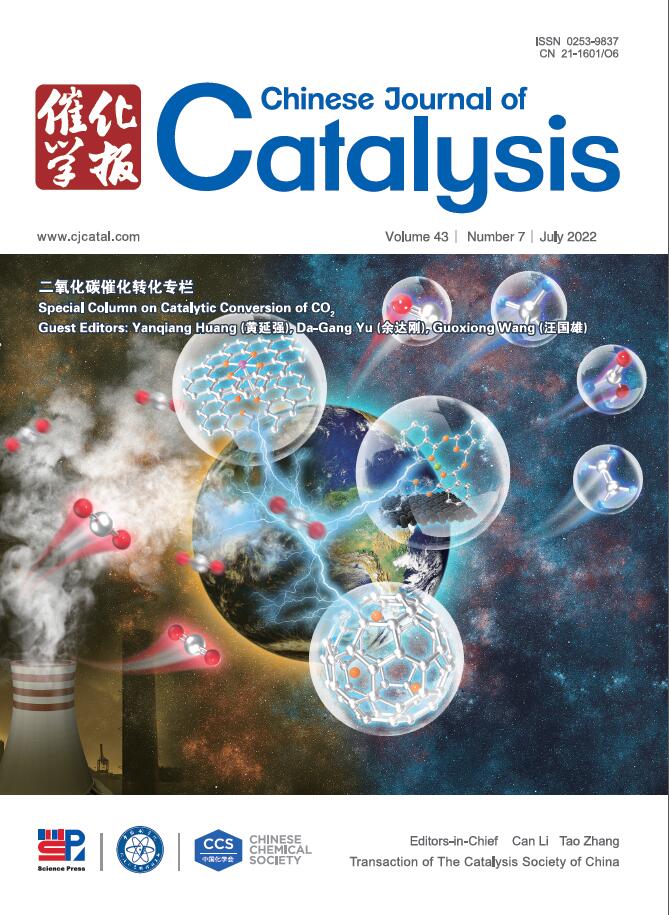Surface defect engineering of ZnCoS in ZnCdS with twin crystal structure for visible-light-driven H2 production coupled with benzyl alcohol oxidation
IF 15.7
1区 化学
Q1 CHEMISTRY, APPLIED
引用次数: 0
Abstract
Photoredox dual reaction of organic synthesis and H2 evolution opens up a novel pathway for collaboratively generating clean fuels and high-quality chemicals, providing a more effective approach of solar energy conversion. Herein, a surface defect-engineered ZnCoS/ZnCdS heterostructure with zinc blende (ZB)/wurtzite (WZ) phase junctions is synthesized for photocatalytic cooperative coupling of benzaldehyde (BAD) and H2 production. This surface defect-engineered ZnCoS/ZnCdS heterostructure elaborately integrates the mixed phase junction advantage of ZnCdS semiconductor and the cocatalytic function of ZnCoS possessing Zn (VZn-ZnCoS/ZnCdS) or S vacancies (VS-ZnCoS/ZnCdS). The optimum VS-ZnCoS/ZnCdS simultaneously exhibits a superior H2 production rate of 14.23 mmol h−1 g−1 accompanied with BAD formation rate of 12.29 mmol h−1 g−1 under visible-light irradiation, which is approximately two-fold greater than that of pristine ZnCdS. Under simulated sunlight irradiation (AM 1.5), VS-ZnCoS/ZnCdS achieves H2 evolution (27.43 mmol gcat−1 h−1) with 0.52% of STH efficiency, accompany with 26.31 mmol gcat−1 h−1 of BAD formation rate. The underlying solar-driven mechanism is elucidated by a series of in-situ characterization and control experiments, which reveals the synergistic effect of interfacial ZB/WZ phase junctions in ZnCdS and S vacancies of ZnCoS on enhancement of the photoredox dual reaction. The VS-ZnCoS/ZnCdS follows a predominant oxygen-centered radical integrating with carbon-centered radical pathways for BAD formation and a simultaneous electron-driven proton reduction for H2 production. Interestingly, the nature of surface vacancies not only facilitates the separation of photoinduced charge carriers but also able to selectively adjust the mechanism pathway for BAD production via tuning the oxygen-centered radical and carbon-centered radical formation.
双晶ZnCdS中ZnCoS的表面缺陷工程研究
有机合成和H2演化的光氧化还原双反应为协同生产清洁燃料和高质量化学品开辟了新的途径,为太阳能转化提供了更有效的途径。本文合成了一种具有闪锌矿(ZB)/纤锌矿(WZ)相结的表面缺陷工程ZnCoS/ZnCdS异质结构,用于光催化苯甲醛(BAD)的协同偶联和制氢。这种表面缺陷工程的ZnCoS/ZnCdS异质结构巧妙地结合了ZnCdS半导体的混合相结优势和ZnCoS具有Zn (VZn-ZnCoS/ZnCdS)或S空位(VS-ZnCoS/ZnCdS)的共催化功能。优化后的VS-ZnCoS/ZnCdS在可见光照射下的H2生成速率为14.23 mmol h−1 g−1,BAD生成速率为12.29 mmol h−1 g−1,是原始ZnCdS的2倍左右。在模拟阳光照射(am1.5)下,VS-ZnCoS/ZnCdS以0.52%的STH效率实现H2的生成(27.43 mmol gcat−1 h−1),同时BAD的生成速率为26.31 mmol gcat−1 h−1。通过一系列的原位表征和控制实验,揭示了ZnCdS中ZB/WZ相界面结和ZnCoS的S空位对光氧化还原双反应增强的协同作用。VS-ZnCoS/ZnCdS主要遵循氧中心自由基与碳中心自由基结合形成BAD的途径,同时电子驱动的质子还原生成H2。有趣的是,表面空位的性质不仅有利于光诱导载流子的分离,而且能够通过调节氧中心自由基和碳中心自由基的形成来选择性地调节BAD产生的机制途径。
本文章由计算机程序翻译,如有差异,请以英文原文为准。
求助全文
约1分钟内获得全文
求助全文
来源期刊

Chinese Journal of Catalysis
工程技术-工程:化工
CiteScore
25.80
自引率
10.30%
发文量
235
审稿时长
1.2 months
期刊介绍:
The journal covers a broad scope, encompassing new trends in catalysis for applications in energy production, environmental protection, and the preparation of materials, petroleum chemicals, and fine chemicals. It explores the scientific foundation for preparing and activating catalysts of commercial interest, emphasizing representative models.The focus includes spectroscopic methods for structural characterization, especially in situ techniques, as well as new theoretical methods with practical impact in catalysis and catalytic reactions.The journal delves into the relationship between homogeneous and heterogeneous catalysis and includes theoretical studies on the structure and reactivity of catalysts.Additionally, contributions on photocatalysis, biocatalysis, surface science, and catalysis-related chemical kinetics are welcomed.
 求助内容:
求助内容: 应助结果提醒方式:
应助结果提醒方式:


